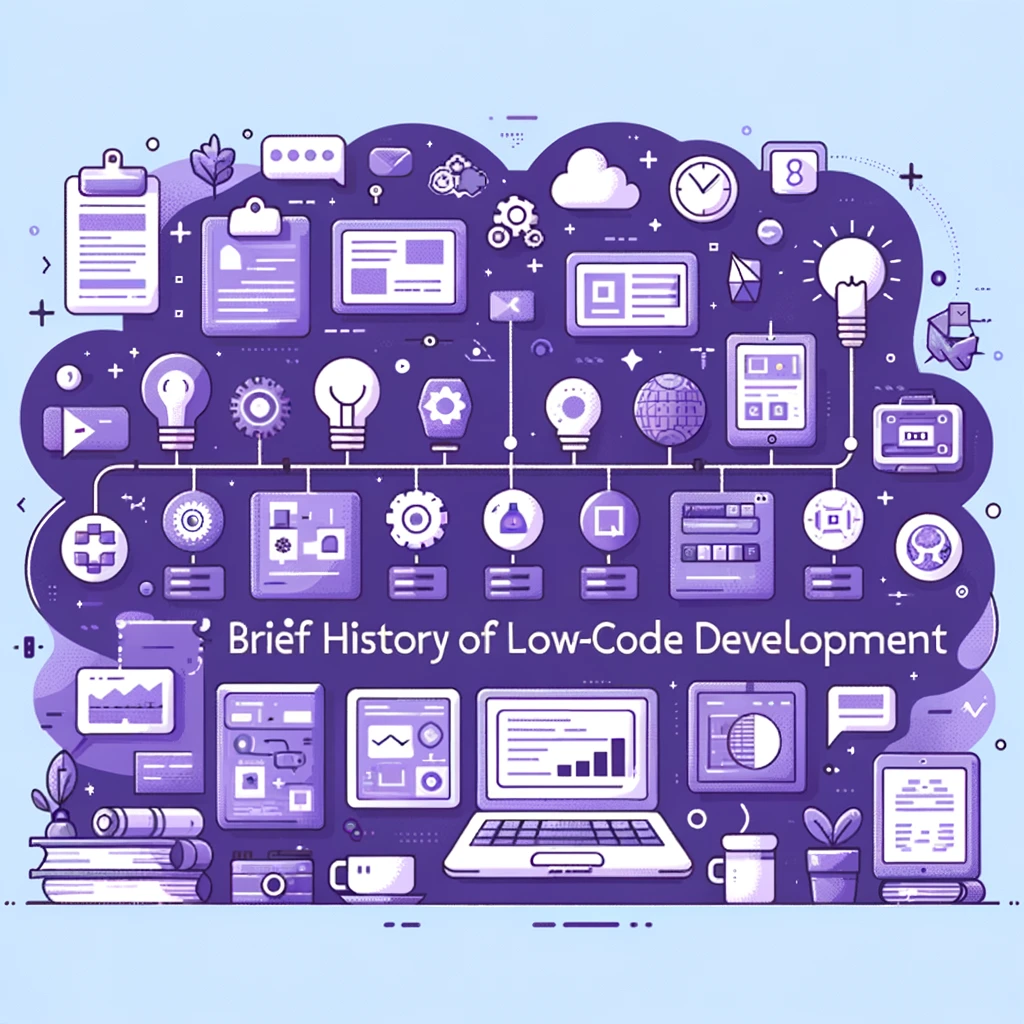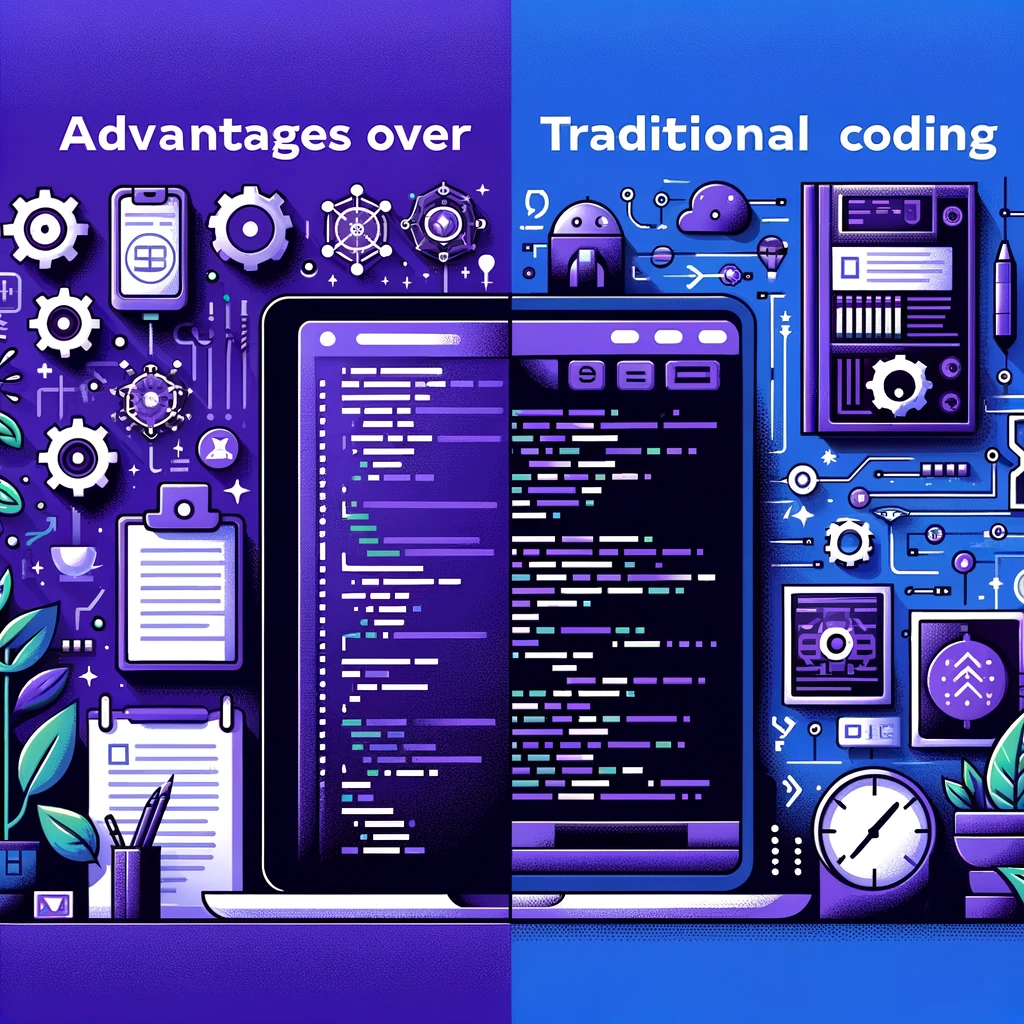Low-code application development has exploded in popularity in recent years as a way for companies to build custom applications quickly without extensive coding expertise. These intuitive platforms, like low-code and no-code platforms, allow people with little to no programming experience, referred to as citizen development, to assemble apps visually via simple drag-and-drop interfaces and configuration instead of traditional coding. As low-code matures, it is poised to revolutionize how software is built in organizations of all sizes.
The Rise of Low Code Platforms
Low-code platforms have revolutionized software development over the last decade. Unlike traditional coding, low code allows those with little to no programming experience to visually assemble applications using simple drag-and-drop interfaces and configuration instead of lines of code.
The concept of low code first emerged in the early 2000s, but the tools have rapidly matured in recent years. The catalyst enabled more agile delivery of business applications when demand was outstripping developer capacity. Leading technology research firm Gartner predicts that by 2024, about 65% of all app development will utilize low-code tools.
The benefits of low code for businesses are multi-fold. Low code speeds up app delivery by 10x or more versus standard coding, becoming instrumental in the future of development. It also expands developer talent pools to business users outside IT. Citizen developers can support agile processes and prototypes. Low code also reduces app backlogs from months to days or weeks. Moreover, it allows IT teams to focus their abilities and effort on more intricate tasks, this showcases why low-code is the future.
The low-code market has expanded nearly 30% annually since emerging less than a decade ago. Major platforms include Appian, Mendix, OutSystems, and Microsoft Power Apps, with revenue in the billions. Low-code promises to transform application development and delivery across enterprises as capabilities grow.

What is Low Code Development?
Low code development is a streamlined approach to building software applications and processes using visual, drag-and-drop interfaces and configuration instead of traditional hand-coding. Low-code platforms provide templates, connectors, and business logic libraries that allow people with little to no coding experience to assemble applications.
Some key characteristics of low code development include:
- Graphical interface - Apps are built visually using pre-built components via a simple drag-and-drop interface, hiding the complexity of underlying code.
- Metadata-driven logic - Much of an app's functionality is derived from configurations and declarative tools instead of hard-coded processes.
- Cross-platform abilities - Apps can be deployed across web, mobile, and device platforms.
- Integration capabilities - Low code platforms come with pre-built integrations to databases, APIs, and more.
- Rapid iteration - The visual interface allows faster prototypes and modifications.
The main goal of low code is expanding the number of people in an organization who can build apps and automate workflows by abstracting traditional programming. It aims to solve the bottleneck caused by technical skill shortages and meet business needs faster.
Low-code and No-code Development
There is an essential distinction between low-code and no-code software for application development:
Low-code Development:
- It still involves some hand coding and technical expertise for application development but at a significantly reduced level compared to traditional coding.
- Provide visual, declarative tools and pre-built components to accelerate development without writing custom code and logic.
- Allow citizen developers and business users to build simple applications, but IT developers may still be required to participate, mainly for integration, complex logic, customization, etc.
- Examples include Mendix, OutSystems, and Appian.
No-code Development:
- Require little to no hand-coding at all for application creation. Instead, they provide visual builders, configuration over coding, and reuse of pre-existing components.
- It can sometimes enable business users and non-developers to build applications end-to-end without developers.
- Target mainly CRUD and simple data-driven apps; limited capabilities for complex custom logic.
- Examples of no-code and low-code platforms include Zoho Creator, Quickbase, and Caspio.
In summary, low-code still generally offers more advanced capabilities than no-code platforms in exchange for some required coding expertise. The level of complexity and integration needed determines whether a low-code or no-code approach makes more sense. But both accelerate delivery and open up development to more non-traditional developers.

Brief History of Low-code Development
The origins of visual development date back to the early 2000s, when the goal was to enable faster application development by non-programmers. Initial tools focused on providing graphical interfaces and simple logic configurations to replace coding workflows.
In 2011, an analyst firm called Forrester Research coined the term "low code" development platforms. Around this time, early commercial solutions launched from vendors like Appian and Mendix aimed at democratizing software delivery for business users. Adoption remained niche, though, as capabilities were still fairly basic.
Growth accelerated in the mid-2010s with improving low code tooling and increasing app demands straining developer bandwidth. Low code expanded people's ability to build apps 10X by abstracting code complexity behind intuitive interfaces.no- The market overgrew as businesses sought solutions to app backlogs and digital transformation needs.
By 2019, low code matured from basic business CRMs and databases into full-stack enterprise application development. As functionality grew on par with coding, adoption expanded. IT leveraged low code for faster deliveries and empowered "citizen developers" on the business side.
Low-code has become mainstream, enabling high-impact applications across industries, consumer experiences, and workflows. Continued capability expansion through cloud-based low-code platforms is shaping the future of software development and driving democratization.
Importance and the Current Technological Landscape
In recent years, low-code development platforms have emerged to accelerate application delivery by providing visual, declarative techniques instead of traditional hand-coding. These platforms enable faster app development with minimal coding, allowing businesses to quickly improve time-to-market and respond to changing market dynamics. However, low code also has some inherent limitations that are important to weigh.
This section will analyze the key benefits and downsides of adopting a low-code approach for application development. We will examine how low-code platforms can drive heightened productivity, faster delivery, and expanded access to products for non-technical staff. Additionally, we will discuss some of the current restrictions of low-code, including dependence on proprietary platforms, challenges in building the most complex systems, and issues integrating with existing infrastructure.
Understanding these pros and cons allows organizations to decide when low-code works best and how to maximize its advantages while mitigating risks. The ability to more rapidly meet business needs through IT projects provides a compelling incentive to utilize low-code. Still, organizations must set reasonable expectations and have a strategy for more limited or mission-critical applications. By examining the tradeoffs, enterprises can effectively incorporate low-code as part of a more innovative, balanced application development landscape.
Advantages:
- Increased productivity - Low-code platforms allow developers to create applications faster with less hand-coding. The no-code development method can significantly accelerate the software development process.
- Faster time-to-market - With productivity gains, low-code enables companies to launch new applications and features much faster.
- Easier maintenance - Applications built with low-code programming are typically easier to maintain and update since less complicated code is involved.
- More comprehensive access to development - Low-code democratizes development, allowing more business users and non-developers to build simple apps and automation. This spreads development capability across the organization.
- Lower costs - The improvements in productivity and efficiency with low code translate into lower overall development costs and resources needed.
- Cross-platform abilities - Many low-code platforms allow the development of web, mobile, and other media using a single integrated development environment.
Disadvantages:
- Limitations for complex systems - While great for simple apps, low-code lacks the full customization and control typically needed for highly complex, mission-critical software systems.
- Vendor dependence - Organizations rely heavily on the low-code vendor's platform and language, which can lead to vendor lock-in. Since low-code programming is involved, it might appear difficult to move apps away.
- Scalability concerns - It remains to be seen how well some low-code apps scale, significantly larger enterprise applications with heavy load and data requirements.
- Integration challenges - Integrating with existing legacy systems and external data sources can be tricky with low-code platforms. Coding skills may still be required.
- Security and governance - Enterprises need to enact robust control for low-code to properly evaluate security, compliance, testing, and approval protocols for these apps and citizen developers.
Here are details on some of the key benefits of low code platforms over traditional coding, as well as adoption statistics and market size:

Advantages Over Traditional Coding:
Speed
- Low code platforms enable 10x faster application development cycles over hand-coding through visual interfaces and pre-built components. This allows faster prototypes and modifications and significantly helps to write code.
Less Need for Programmers
- Low-code abstraction removes much of the complex coding for custom apps, enabling non-technical staff like business analysts to build applications without dependencies.
Adoption Rates and Market Size Statistics:
- By 2024, IDC predicts over 65% of all app development will happen on low-code platforms.
- In 2021, Forbes measured low-code adoption in the enterprise sector at over 50% for companies building consumer/employee-facing apps, a testament to the future of low-code.
- According to Grand View Research, the global low-code development market is projected to grow from $13.2 billion in 2019 to $187 billion by 2030, representing a compounded annual growth rate of 29%.
This high growth underscores how low code development is mainstream across organizations to condense software delivery cycles, reduce app backlogs, and enable digitization efforts without excellent technical skills.
Current State of Low Code Development
The low code revolution is more than hype – it has become a mainstream staple empowering digital transformation and software innovation across industries. Let's examine the current maturity of the low code market beyond the promise of 10x faster development cycles and expanded app creator pools.
Major Enterprise Platforms Lead the Charge Low-code platforms have consolidated around a few enterprise-ready vendors. Microsoft Power Platform currently leads the market, enabling low-code development on Azure as part of a robust business application stack. Appian, Mendix, and OutSystems feature next in market share for advanced enterprise low-code dev tools. Additional leaders include Salesforce, Oracle, Pegasystems, and more.

Demonstrating tangible value, low code adoption continues to accelerate based on proven value driving quantifiable business results, making it a promising development method for future software solutions.
- Telehealth Apps Bring Smarter Patient Care: St. Luke's University Health Network met surging pandemic telemedicine demands by launching low-code patient screening and physician collaboration apps in weeks instead of months.
- 75% Faster Mortgage Origination: Fannie Mae applied low code to condense an unwieldy legacy mortgage processing system. It reduced loan approval times from 3 weeks to 5 days while cutting origination costs.
- Streamlining military Enrollment Systems involves using low-code development tools. Britain's Royal Navy transformed recruited onboarding by leveraging low code to condense a four-hour paper process into a 20-minute self-service portal experience.
Core Advantages Align to Digital Transformation Mandates
Low code enables several compelling benefits, explaining its maturation for mission-critical systems:
- 10x Faster Speed: Condensing months-long release schedules to weekly app iterations aligns better with Agile delivery needs.
- Widen Developer Talent: Empowering business analysts and power users to build apps offsets severe technical talent bottlenecks.
- Quickly Meet Changing Needs: Visual configuration adjustments enable rapid app modifications when requirements evolve.
While limitations remain around scale, governance, and portability, low-code momentum continues building across enterprises. The proof points cement low-code as a pivotal part of future software innovation strategies rather than an isolated tool.
Future Trends in Low Code Development
Integration with AI and Machine Learning
Integrating Artificial Intelligence (AI) and Machine Learning (ML) with low code development platforms is poised to be a game-changer. This synergy aims to empower these platforms to self-improve and optimize processes based on data-driven insights.
Integrating artificial intelligence (AI) and machine learning into low-code platforms is an emerging trend that will empower faster and smarter application development.
Low-code solutions can leverage AI in a few key ways:
- AI-assisted development - Platforms will incorporate predictive suggestions and recommendations to guide developers in designing applications and workflows. This helps automate rote design tasks.
- Intelligent process automation - Low-code apps can be embedded with AI to add capabilities like natural language processing, intelligent data capture, chatbot integration, and more to drive automation.
- Generative UI design - Leveraging advanced software solutions like generative adversarial networks (GANs), ML helps automatically generate aesthetic user interfaces for low-code apps by learning design patterns.
- Testing enhancement - AI will help automate steps like test case creation, test data generation, and identifying hard-to-catch bugs through behavioral anomaly detection.
With these AI and ML advancements, enterprises can build more competent, more advanced applications faster with their low-code platforms. Companies like Microsoft, Salesforce, and Appian are already pioneering the integration of AI into low-code. This convergence will ultimately enable more intelligent, self-operating applications. The productivity gains also allow developers to focus less on manual coding and more on delivering business impact.
Development to New Industries
Low-code development platforms have traditionally been popular in financial services, insurance, healthcare, and other data-intensive industries. However, as the capabilities advance, we will see significantly wider adoption of low-code across sectors. Here are some examples:
FinTech
- Rapid prototyping of new digital banking/financial products
- Automation of lending, insurance claims, and other processes
- Low-code development tools aid in rapidly developing customer-facing applications like mobile wallets and trading platforms.
- Integration with blockchain, digital payments, and cryptocurrencies
The agility of low code allows FinTech startups, as well as established financial institutions, to accelerate innovation.
The events/Hospitality sector will hugely benefit from development tools for low-code applications.
- Building custom event apps and mini-programs
- App integration with registration, scheduling, and attendee engagement is a relevant low-code application.
- Enabling contactless experiences via mobile
- Real-time data and dashboards for event logistics management
Low-code and no-code tools will drive transformation around guest experiences and streamline event operations from concerts to conferences. The ability to quickly adapt to changing business processes makes low-code applications a strong fit in this scenario.
Retail & Commerce: Low-code allows retailers to rapidly build customer-facing mobile apps, integrate new in-store technologies, and adapt to changes in purchasing behavior.
Energy & Resources: Improving renewable energy management, optimizing supply chain/logistics, and enabling real-time decision-making are critical low-code use cases for the Energy industry.
Government: Streamlining constituent services, modernizing legacy systems, and automating processes for managing compliance/reporting needs are government areas ripe for low-code transformation.
Education: Universities and institutional campuses must automate administration tasks, build custom portals for students and faculty, and digitize paperwork handling processes.
As low-code platforms expand functionality, integrate with emerging tech like IoT and Blockchain, and allow multi-experience development, more industries will take advantage of their application needs. The productivity and faster delivery of low-code applications will drive innovations across sectors, shaping the future of software development.
Increasing Customization and Flexibility in Low Code Platforms
The future of low-code platforms will focus on more modular architectures and increased openness to ease customization, mitigate vendor lock-in risks, and streamline the software development process. Here are some key ways this evolution will unfold:
- Greater access to underlying source code - Platform vendors will allow controlled access to source code to facilitate complex customizations, integration needs, and future migration.
- More open integration capabilities - Open APIs, an extensive library of connectors, and web services integration will provide seamless interoperability with external systems.
- Support for expanded functionality via add-ons/plugins - Low code vendors will encourage ecosystems of third-party add-ons to their platform to allow extensions for niche use cases.
- Evolution to containerized architectures - Transitioning to microservices-based architectures will enable more modular customization of low-code platforms.
- Configuration over customization mindset - While offering customization capabilities, the focus will remain on configuration-based flexibility to avoid unnecessary code complexity.
Enabling personalization and escaping vendor lock-in is critical to low code adoption in the enterprise. Striking the right balance between a platform approach and custom extensibility will define the leading platforms in the future.
Impact on Traditional Software Development
Low-code platforms will significantly impact the traditional software development landscape in the years to come, shaping the future of development. Here are some key ways it may alter conventional and future development:
- The focus shifts towards business logic and custom capabilities. Low-code will care for the routine application needs, enabling developers to apply their skills to complex reasoning and innovative functionality.
- Creates convergence with IT development - Citizen developers using low-code will still need integration and guidance from IT development teams. They will increasingly work in tandem.
- Expands the developer pool significantly - The technology-skilled workforce using low code will expand considerably, allowing enterprises to take on more digital initiatives concurrently and at scale.
- Reshape developer skills profiles for the future of development - Demand will grow for developer skills like integrating third-party apps/APIs, microservices development, optimizing cloud architectures, DevOps, etc.
- Evolves development culture - Companies must instill testing, governance, and enterprise DevOps best practices into low-code practices to ensure a quality and secure approach to application development.
In essence, low-code stands to significantly expand access to application development to more users across organizations while allowing IT developers to focus innovation efforts on more complex needs. It will ultimately lead to the democratization of development capability.

Challenges and Opportunities
Security Concerns in Low Code Development
One of the pressing challenges in low code development is ensuring robust security measures. The ease of use and accessibility of low-code platforms can potentially lead to lapses in security protocols, primarily when used by individuals with a limited understanding of cybersecurity principles. Risks include data breaches, unauthorized access, and vulnerability to cyber-attacks. To mitigate these risks, low-code platforms must incorporate advanced security features and establish strict governance policies for organizations. Regular security audits and user training safeguard applications against potential threats. Addressing these security concerns is essential to maintaining trust and reliability in low-code solutions.
Skills and Talent Development for Low Code Development
As low-code platforms gain traction, there's a growing need to develop specific skills and talent in this domain. While low code development is designed to be user-friendly, effectively leveraging these platforms for complex solutions requires a nuanced understanding of system integration, process optimization, and basic coding principles. The evolving landscape calls for a redefinition of the IT professional's role, emphasizing skills in project management, analytical thinking, and creative problem-solving. Educational institutions and organizations must adapt, offering training programs and workshops to equip the workforce with the necessary skills to excel in this new environment. This shift towards low code and no code development tools represents both a challenge and an opportunity for professional development in the IT industry.
Opportunities for Innovation and Collaboration
Low code development opens a plethora of opportunities for innovation and collaboration. By simplifying the application development process, these platforms lower the barriers to entry, allowing a more diverse group of individuals to contribute to software creation. This inclusivity fosters a rich breeding ground for innovative ideas, as people from different backgrounds and expertise can collaborate more efficiently. Companies can harness this potential to accelerate digital transformation, develop custom solutions rapidly, and respond swiftly to market changes. Furthermore, low-code platforms can facilitate partnerships between IT and other departments, leading to more cohesive and well-rounded solutions that align closely with business needs.
Potential Impact on Employment and the IT Industry
The rise of low code development is poised to impact employment and the IT industry significantly. On one hand, it democratizes software development, potentially reducing the demand for traditional coding skills. Routine coding tasks might decline, leading to a shift in job roles within the IT sector. On the other hand, it also creates new opportunities for IT professionals to focus on more complex, strategic aspects of software development. The challenge lies in balancing the automation offered by low-code platforms with the need for human expertise, ensuring that the workforce adapts to these changes through upskilling and reskilling. In the long term, low code development could lead to a more versatile and dynamic IT industry with a broader range of career paths and specializations.
Conclusion
Exploration of low-code development reveals its immense potential to revolutionize software creation across industries. This paradigm shift is marked by integrating AI and machine learning, expanding the reach of low-code solutions into diverse sectors, increasing platform customization, and influencing traditional software development practices. The agility, efficiency, and inclusivity offered by low-code platforms position them as pivotal tools in the future of digital transformation. Their ability to democratize application development and accelerate innovation signifies a significant leap forward in how technology solutions are crafted and implemented.
For businesses, the key is to embrace low code development as a strategic asset. Investing in training and governance frameworks will ensure that these tools are used effectively and securely. Businesses should explore low-code platforms not just as a means to reduce costs but as a way to drive innovation and stay agile in a rapidly changing market. On the other hand, developers should view low-code platforms as an opportunity to augment their skills. Emphasizing learning platform-specific capabilities, understanding integration with existing systems, and focusing on complex problem-solving will ensure their relevance in an evolving industry. Collaboration between developers and non-technical teams can provide more comprehensive and practical solutions.
Low-code development is a trend and a transformative force in the software development landscape. Its impact extends beyond simplifying the creation of applications to reshaping the roles within IT departments and altering the traditional software development methodologies. The future envisions a collaborative ecosystem where low-code and traditional coding methodologies coexist, each playing to their strengths. This synergy promises a more inclusive, innovative, and efficient approach to solving technological challenges, heralding a new era in software development that aligns with the dynamic demands of the digital age.









